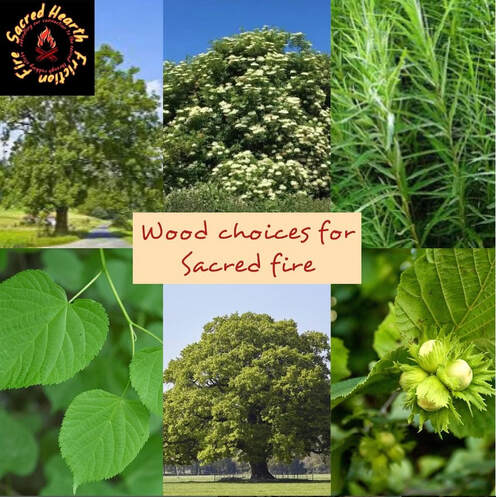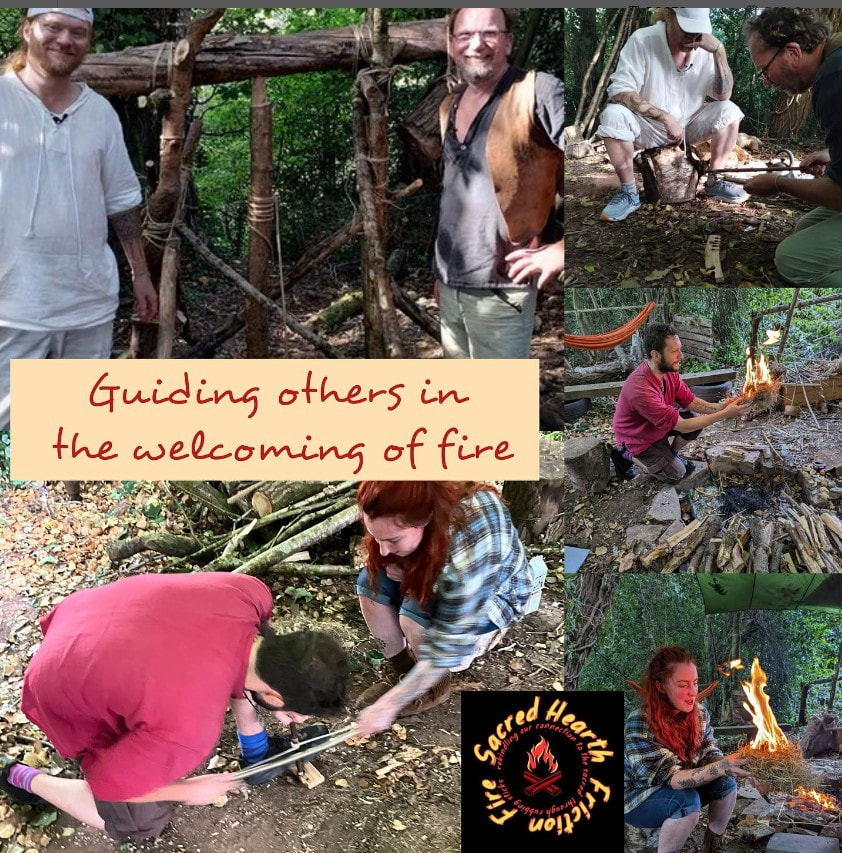|
I don’t mandate any way of conducting fire rituals. I do not follow any particular belief but my own path.I endeavour not to appropriate from other cultures. my focus now is welcoming fire in ritual for use in uk My practice has evolved from 9 years of rubbing sticks and being involved in sacred practice over 20 years and my research into neid fire
I guide people in how to welcome fire by rubbing sticks and pass on knowledge and skills so they can use in thier own practice and pass on to others. With Neid Fire I guide people in materials needed. I share the history, folklore and myths surrounding Neid Fire and that it was used for hundreds of years in ritual in UK before being wiped out in the 19th c. Use of Friction fire was then mainly absent (in uk) for over a hundred years until bushcraft/survival movement. I am trying to address the absence of Neid fire and welcoming of fire in a sacred way in the UK to pass on to others. I share what is important for me and pass on the knowledge I have gained so people can dream into and weave in what is important to them. Ritual can be influenced by time of year / beliefs / spiritual path / the land/ nature/ local customs/folklore / a theme / a crisis etc etc that can all be weaved in . Traditionally Neid Fire was for use in time of need and auspicious events. I can work with people to make the Neid Fire apparatus and use it in communal ritual so they can perform thier own rituals and pass on the tradition themselves. Thankfully I know this practice is still alive within Eastern Europe/Slavs /Baltics/Russia - it is Western Europe where it seems to have been buried in the ashes (mostly - I know I am not the only one out there and know of a few times it’s been used in last 10 years just not widely known ) “Apprentice of fire”.
I recently saw someone use that phrase and it really struck a chord with me. As well as a welcomer of fire or is that a fire welcomer I will always be an apprentice of fire Or one could say a disciple of fire. I shall never be a master of fire. It’s like “fire keeper” - are we the keeper of fire or is fire the keeper of us 🙏 I welcome and tend the ancestral fire I love exploring the language of fire - language is important to me and my use of it evolves as I continuously explore my connection with fire. No doubt I shall dream into more phrases for welcoming and tending the sacred flame 😀🙏 I coax the embryonic ancestral fire out of hiding from the wood I welcome the ancestral fire through breath I’m always learning Connecting and honouring And passing on to others Without fire we wouldn’t be here. We are forged from fire.  Wood choices for sacred fire… I don’t mandate any particular wood - what is important for me personally is:
1-it’s native to where I am 2- preferably it’s sourced local to where I am welcoming fire (if at all possible) 3-it’s been collected from fallen/dead standing wood or it’s overly abundant and has been harvested sustainably My preferred wood for bow drill in ritual is English Oak which has been collected from wind fallen branches. Hazel is my favourite tree and loves having fire coaxed from her and commonly sheds branches. For sacred/ritual practice I collect my wood in advance and season There are lots of combinations for bow drill and it can be a personal choice.I also make my own cordage usually from nettles With Neid Fire I am working on a larger scale and so I am reliant on what I can find which has naturally fallen - I have Hazel and Ash spindles and Hazel and Poplar hearth logs and Holly for the bearing log. I kept/keep scouring the woods to find suitable fallen branches/trees.And for Neid Fire you need to collect in advance and season Traditionally Oak was used for Neid fire but it is very difficult to find suitable fallen oak and I would NEVER cut a live Oak for my own purposes and I DO NOT advocate cutting live Oak. For the fire wood - for me it is importent that it is native, local (if poss) and collected from fallen wood and is a good burning wood and is dry - I commonly use hazel and/or birch first (fast burning) then ash or seasoned oak. Again I collect in advance and season. (These woods are all native and local to me) The sourcing, collecting and preparing the wood is a huge part of my friction fire practice which I endeavour to do with awareness and respect and gratitude -for neid fire it can take several months I’m blessed in that I live next to woods with Hazel, Oak, Elder, Ash, Hawthorn, Elm, Poplar, Willow, Tilia, Ivy, Clematis Sacred Fire has been central to many cultures
A commonality is that fire deities were often female (Hestia, Vesta, Brigit etc) and the sacred fires tended by women and they would rekindle the fire using friction fire on a cyclic pattern. Within the community it would be women who tended the hearth fires. (note-the pic is only pic I could find of women doing a fire ritual – lighting Olympic torch via solar) The emergence of Christianity saw the end of these traditions and as we know many many women (and yes men too – but mostly women) were brutally persecuted and the old ways mostly eradicated. Largely unknown is the Neid Fire friction fire ritual that was once widespread throughout Europe –The Church saw it as heathen and so was abolished. The last records of Neid Fire in Scotland was 1840s. There is a lack of info in Eire. Wiped from the ancestral memory. Friction fire in a sacred way was a part of our cultural heritage and is very different to bushcraft/survival friction fire. The modern bushcraft/survival movement started in the 60s/70s has become a huge global industry. Largely it has been male dominated but that is now fortunately changing. Friction fire has become popular through bushcraft/survival movements and it is a very good thing otherwise we would have lost the skills (tho fortunately indigenous peoples continue to use friction fire) In recent times - fire starting (inc friction fire) has been seen to be more male dominated and at times macho There has been a mis-conception that it is more suited to “men”🤬 Let’s remember who tended our sacred hearths I have taught many women and it’s fantastic to see more women using and teaching friction fire. Traditionally fire by friction has been a communal practice and not about proving how fast/quick you can coax an ember on your own. We’ve lost our heritage of ritual fire. What is missing is teaching friction fire in sacred/holistic way - I am trying to address that and encourage people to learn and use and pass on the knowledge and skills to others I feel we need to throw off the burdens of the past; reclaim our cultural heritage and reconnect to nature, the land, ourselves, each other and be kind 🙏 What methods do I use for welcoming fire? The clue is in my name 😀
I can’t actually remember the last time I didn’t use friction fire for “lighting” an outdoor fire - over 5 or 6 years ago at least maybe more (I may have “played” with other methods but not for consciously welcoming fire) Friction fire is my way, my passion, my practice , my calling - and I use it every opportunity I have so if a fire needs welcoming by me it shall be by rubbing sticks together. The 4 main friction methods I use now are:
( I have also experimented lots with various variations inc pump drill, mouth drill, arm bow drill, pedal drill, fire saw, coat hanger bow drill, stationary bow drill, kitchen utensil bow drill etc , lots of variations of bow drill and have lots of fun doing so 😀 there is a humorous side to me too 😀that sometimes comes out in ritual - ritual does not always need to be serious I own a ferro rod and have used one on occasion (let’s just say they are not for me - I don’t like them) I do have a fire piston for demos I can’t get on with flint and steel either but I don’t need to - friction fire is my path 😀 We have lost the knowledge and skills and in Europe part of our cultural heritage (neid fire) was buried and taken away from us - it is my calling to try and help rekindle our connection to fire in a sacred way through rubbing sticks. Fire ritual was once a huge part of our cultural heritage. SHFF now offers Journey with Fire experiences - contact Ian @sacredhearthfrictionfire for more info Blessings on the ancestral fire 🔥 Ian 🙏 #ancestralfire #sacredfire #ritualfire #alternativebristol #firebyfriction #frictionfire #mindbodyspirit |
Archives
January 2024
Categories
All
|



 RSS Feed
RSS Feed